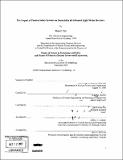The impact of passive safety systems on desirability of advanced light water reactors
Author(s)
Eul, Ryan C
DownloadFull printable version (16.60Mb)
Other Contributors
Massachusetts Institute of Technology. Technology and Policy Program.
Advisor
Mujid S. Kazimi.
Terms of use
Metadata
Show full item recordAbstract
This work investigates whether the advanced light water reactor designs with passive safety systems are more desirable than advanced reactor designs with active safety systems from the point of view of uncertainty in the performance of safety systems as well as the economic implications of the passive safety systems. Two advanced pressurized water reactors and two advanced boiling water reactors, one representing passive reactors and the other active reactors for each type of coolant, are compared in terms of operation and responses to accidents as reported by the vendors. Considering a simplified decay heat removal system that utilizes an isolation condenser for decay heat removal, the uncertainty in the main parameters affecting the system performance upon a reactor isolation accident is characterized when the system is to rely on natural convection and when it is to rely on a pump to remove the core heat. It is found that the passive system is less certain in its performance if the pump of the active system is tested at least once every five months. In addition, a cost model is used to evaluate the economic differences and benefits between the active and passive reactors. It is found that while the passive systems could have the benefit of fewer components to inspect and maintain during operation, they do suffer from a larger uncertainty about the time that would be required for their licensing due to more limited data on the reliability of their operation. Finally, a survey among nuclear energy experts with a variety of affiliations was conducted to determine the current professional attitude towards these two competing nuclear design options. The results of the survey show that reactors with passive safety systems are more desirable among the surveyed expert groups. The perceived advantages of passive systems are an increase in plant safety with a decrease in cost.
Description
Thesis (S.M.)--Massachusetts Institute of Technology, Dept. of Nuclear Science and Engineering; and, (S.M.)--Massachusetts Institute of Technology, Engineering Systems Division, Technology and Policy Program, 2006. Includes bibliographical references (leaves 121-123).
Date issued
2006Department
Massachusetts Institute of Technology. Department of Nuclear Science and Engineering; Massachusetts Institute of Technology. Engineering Systems Division; Technology and Policy ProgramPublisher
Massachusetts Institute of Technology
Keywords
Nuclear Science and Engineering., Technology and Policy Program.